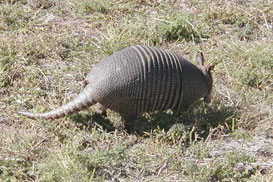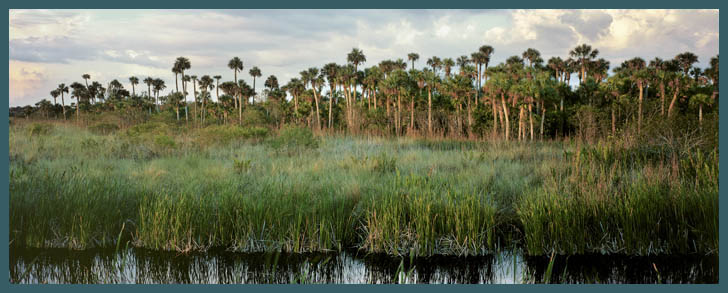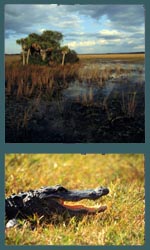|
Florida Everglades
Armadillos in Florida!

photo provided by National Park Service - US Department of the Interior (photographer Dan Siefert) |
These small, prehistoric-looking mammals, with their leathery armor shell have consistently expanded their range during the past century from Texas into the Florida Panhandle area and beyond. It has also been reported in several sources that the Florida armadillo population was the result of a few animals released from a small zoo back in 1924, combined with several more that escaped from a traveling circus in 1936 and what we have today are their offspring. What we do know is that the armadillo is currently found in uplands throughout Florida, except in parts of the Everglades, the Big Cypress Swamp and the Keys. The Spanish word armadillo means "little armored one".
According to the Professor of Entomology Dr. Russell F. Mizell, III, from Quincy, Florida, "there are actually about 20 species of armadillos in the world, but the only non-native, common inhabitant of Florida is the nine-banded or long-nosed armadillo." This nine-banded armadillo (Dasypus novemcinctus) is named for the nine breaks in its armor which enables it to flex its stiff leathery hide. In addition to its armored shell, it is also covered with horny scales; and the only parts without the bony armor are their ears and stomach. It is the only mammal in Florida with an exoskeleton - an external skeleton that supports and protects the animal's body.
Measuring about the size of a cat, mature armadillos range from 15 to 17 inches long and weigh anywhere from eight to 17 pounds. Even though they have poor hearing and eyesight, the armadillo possesses a keen sense of smell that rooting or digging in the ground provide, feeding primarily on insects and larvae. They also eat spiders, snails, earthworms and small vertebrates and their eggs. Researchers have stated that the armadillo have roughly 28-32 peg-like teeth found in simple rows back well into the mouth, but no front teeth. Primarily nocturnal, armadillos prefer forested or semi-open habitats that allow them to dig more easily. Their prolific burrowing and rooting make them quick enemies of many homeowners and golf courses on discovering the large holes they leave behind. Not only are armadillos agile runners, they are also good swimmers too, and tend to frequent both water holes and streams. According to the Florida Fish and Wildlife Conservation Commission website, when faced with a wide body of water, armadillos will inflate their stomachs to twice its normal size, which allows them enough buoyancy to actually swim across.
The female armadillo produces one litter of identical quadruplets from one egg that splits into four offspring - either all male or all female - each year in February or March, following a five-month gestation period. Armadillos can actually have a lifespan reaching 20 years. Did you know that when compared with similar common mammals such as the opossum and raccoon, the armadillo is free of parasites and it has also remained rabies-free as well?
Interestingly, armadillos have been used extensively in the study of leprosy for many years now. Leprosy, a Greek word, meaning a "disease which makes the skin scaly". The spread of leprosy to close contacts can be curbed considerably with antibiotics if diagnosed and treated at the first onset. Today, a person with Hansen's disease can continue to lead an active life and continue working while being treated.
#
The ABCs of the Florida Landscape is written by freelance writer Maureen Sullivan-Hartung who has resided in Naples for nearly 30 years and loves learning about all aspects of the local flora and fauna. Another passion of hers is local history and she authored a book in November 2010, titled, Hidden History of Everglades City and Points Nearby, published by The History Press. Check her website for the book's availability or additional information about the author at www.maureenwrites.com.
msh12011
|


